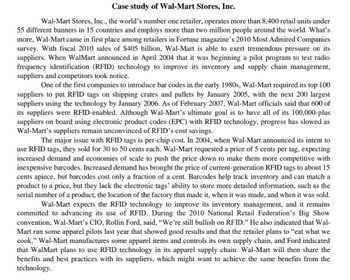
Understanding Business
12th Edition
ISBN: 9781259929434
Author: William Nickels
Publisher: McGraw-Hill Education
expand_more
expand_more
format_list_bulleted
Question
Prepare a cause and effect diagram

Transcribed Image Text:Case study of Wal-Mart Stores, Inc.
Wal-Mart Stores, Inc., the world's number one retailer, operates more than 8,400 retail units under
55 different banners in 15 countries and employs more than two million people around the world. What's
more, Wal-Mart came in first place among retailers in Fortune magazine's 2010 Most Admired Companies
survey. With fiscal 2010 sales of $405 billion, Wal-Mart is able to exert tremendous pressure on its
suppliers. When WalMart announced in April 2004 that it was beginning a pilot program to test radio
frequency identification (RFID) technology to improve its inventory and supply chain management,
suppliers and competitors took notice.
One of the first companies to introduce bar codes in the early 1980s, Wal-Mart required its top 100
suppliers to put RFID tags on shipping crates and pallets by January 2005, with the next 200 largest
suppliers using the technology by January 2006. As of February 2007, Wal-Mart officials said that 600 of
its suppliers were RFID-enabled. Although Wal-Mart's ultimate goal is to have all of its 100,000-plus
suppliers on board using electronic product codes (EPC) with RFID technology, progress has slowed as
Wal-Mart's suppliers remain unconvinced of RFID's cost savings.
The major issue with RFID tags is per-chip cost. In 2004, when Wal-Mart announced its intent to
use RFID tags, they sold for 30 to 50 cents each. Wal-Mart requested a price of 5 cents per tag, expecting
increased demand and economies of scale to push the price down to make them more competitive with
inexpensive barcodes. Increased demand has brought the price of current-generation RFID tags to about 15
cents apiece, but barcodes cost only a fraction of a cent. Barcodes help track inventory and can match a
product to a price, but they lack the electronic tags' ability to store more detailed information, such as the
serial number of a product, the location of the factory that made it, when it was made, and when it was sold.
Wal-Mart expects the RFID technology to improve its inventory management, and it remains
committed to advancing its use of RFID. During the 2010 National Retail Federation's Big Show
convention, Wal-Mart's CIO, Rollin Ford, said, "We're still bullish on RFID." He also indicated that Wal-
Mart ran some apparel pilots last year that showed good results and that the retailer plans to "eat what we
cook." Wal-Mart manufactures some apparel items and controls its own supply chain, and Ford indicated
that Walmart plans to use RFID technology in its apparel supply chain. Wal-Mart will then share the
benefits and best practices with its suppliers, which might want to achieve the same benefits from the
technology.
Expert Solution
This question has been solved!
Explore an expertly crafted, step-by-step solution for a thorough understanding of key concepts.
Step by stepSolved in 3 steps with 1 images

Knowledge Booster
Similar questions
arrow_back_ios
arrow_forward_ios
Recommended textbooks for you
 Understanding BusinessManagementISBN:9781259929434Author:William NickelsPublisher:McGraw-Hill Education
Understanding BusinessManagementISBN:9781259929434Author:William NickelsPublisher:McGraw-Hill Education Management (14th Edition)ManagementISBN:9780134527604Author:Stephen P. Robbins, Mary A. CoulterPublisher:PEARSON
Management (14th Edition)ManagementISBN:9780134527604Author:Stephen P. Robbins, Mary A. CoulterPublisher:PEARSON Spreadsheet Modeling & Decision Analysis: A Pract...ManagementISBN:9781305947412Author:Cliff RagsdalePublisher:Cengage Learning
Spreadsheet Modeling & Decision Analysis: A Pract...ManagementISBN:9781305947412Author:Cliff RagsdalePublisher:Cengage Learning Management Information Systems: Managing The Digi...ManagementISBN:9780135191798Author:Kenneth C. Laudon, Jane P. LaudonPublisher:PEARSON
Management Information Systems: Managing The Digi...ManagementISBN:9780135191798Author:Kenneth C. Laudon, Jane P. LaudonPublisher:PEARSON Business Essentials (12th Edition) (What's New in...ManagementISBN:9780134728391Author:Ronald J. Ebert, Ricky W. GriffinPublisher:PEARSON
Business Essentials (12th Edition) (What's New in...ManagementISBN:9780134728391Author:Ronald J. Ebert, Ricky W. GriffinPublisher:PEARSON Fundamentals of Management (10th Edition)ManagementISBN:9780134237473Author:Stephen P. Robbins, Mary A. Coulter, David A. De CenzoPublisher:PEARSON
Fundamentals of Management (10th Edition)ManagementISBN:9780134237473Author:Stephen P. Robbins, Mary A. Coulter, David A. De CenzoPublisher:PEARSON

Understanding Business
Management
ISBN:9781259929434
Author:William Nickels
Publisher:McGraw-Hill Education

Management (14th Edition)
Management
ISBN:9780134527604
Author:Stephen P. Robbins, Mary A. Coulter
Publisher:PEARSON

Spreadsheet Modeling & Decision Analysis: A Pract...
Management
ISBN:9781305947412
Author:Cliff Ragsdale
Publisher:Cengage Learning

Management Information Systems: Managing The Digi...
Management
ISBN:9780135191798
Author:Kenneth C. Laudon, Jane P. Laudon
Publisher:PEARSON

Business Essentials (12th Edition) (What's New in...
Management
ISBN:9780134728391
Author:Ronald J. Ebert, Ricky W. Griffin
Publisher:PEARSON

Fundamentals of Management (10th Edition)
Management
ISBN:9780134237473
Author:Stephen P. Robbins, Mary A. Coulter, David A. De Cenzo
Publisher:PEARSON